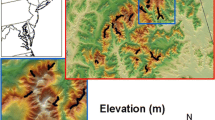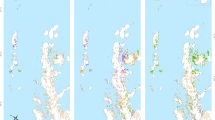Abstract
The phenologies of plants and animals in snow-covered landscapes are expected to accelerate with global warming. However, there are few studies that have examined a range of unrelated taxa in alpine environments to determine whether there is commonality in the proximate causes, synchrony in timing, or the direction of any changes. Records for five alpine animal species and two alpine plant species, chosen primarily for their visibility, were examined to determine their temporal response to regional climate warming. Over the 30-year period studied, they showed an array of different phenological responses. Plant flowering appeared linked to date of snow melt, whereas animal responses varied. Although having accelerated phenologies, two migratory bird species exhibited contrary changes; one to low-altitude warming regardless of snow conditions in the alpine zone (flame robin) and the other to state of the snowpack regardless of low-altitude temperatures (Richard’s pipit). By contrast, the migratory bogong moth arrived significantly later over the years with no apparent explanatory climatic cause. Although bogong moths are not responding to earlier snow melt, insectivorous predators on the ground are. This could lead to a serious mismatch in timing at different trophic levels, putting pressure on endangered vertebrates. Emergence of locally wintering insect species, March flies and Macleay’s swallowtails, were not significantly related to measured climatic parameters over the study period. A consequence of the disparate responses to climate warming recorded here is the questionable value of ‘indicator species’ to examine the impact of climate warming on alpine ecosystems.
Similar content being viewed by others
References
Blakers, R. 1980. Insects in the Alpine Zone. Honours Thesis, Australian National University, Canberra.
Both, C., Bouwhuis, S., Lessells, C.M. and Visser, M.E. 2006. Climate Change and Population Declines in a Long-distance Migratory Bird. Nature 441: 81–83.
Common, I.F.B. 1954. A Study of the Ecology of the Adult Bogong Moth Agrotis infusa (Boisd.) (Lepidoptera: Noctuidae), with Special Reference to its Behaviour During Migration and Aestivation. Australian Journal of Zoology 2: 223–263.
Costin, A.B., Gray, M., Totterdell, C.J. and Wimbush, D.J. 1979. Kosciusko Alpine Flora. CSIRO Collins, Pp. 408.
Costin, A.B., Gray, M., Totterdell, C.J. and Wimbush, D.J. 2000. Kosciuszko Alpine Flora (2nd Edition) CSIRO Publishing, Pp. 398.
Cresswell, W. and McCleery, R. 2003. How Great tits Maintain Synchronization of their Hatch Date with Food Supply in Response to Long-term Variability in Temperature. Journal of Animal Ecology 72: 356–366.
Danks, H.V. 2004. Seasonal Adaptations in Arctic Insects. Integrative and Comparative Biology 44: 85–94.
Dunne, J.A., Harte, J. and Taylor, K.J. 2003. Subalpine Meadow Flowering Phenology Responses to Climate Change: Integrating Experimental and Gradient Methods. Ecological Monographs 73: 69–86.
Duus, A.l. 1992. Estimation and Analysis of Snow Cover in the Snowy Mountains between 1910 and 1991. Australian Meteorogical Magazine 40: 195–204.
Froggatt, W.W. 1900. Caterpillars: The Bugong Moth (Agrotis infusa Boisd.). Agricultural Gazette of NSW 10: 1252–1256.
Gall, B.C. and Longmore, N.W. 1978. Avifauna of the Thredbo Valley, Kosciusko National Park. Emu 78: 189–196.
Gallagher, R.V., Hughes, L. and Leishman, M.R. 2009. Phenological Trends among Australian Alpine Species; using Herbarium Records to Identify Climate-change Indicators. Australian Journal of Botany 57: 1–9.
Green, K. 1982. Migration of an Ichneumonid Wasp over a Subalpine Pass. Victorian Naturalist 99: 260.
Green, K. 1997. Inter-annual, Seasonal and Altitudinal Differences in Invertebrate Activity in the Snowy Mountains. Victorian Naturalist 114: 222–229.
Green, K. 2006. The Effect of Variation in Snowpack on Timing of Bird Migration in the Snowy Mountains. Emu 106: 187–192.
Green, K. 2008. Migratory Bogong Moths (Agrotis infusa) Transport Arsenic and Concentrate it to Lethal Effect by Gregariously Aestivating in Alpine Regions of the Snowy Mountains of Australia. Arctic Antarctic and Alpine Research 40: 74–80.
Green, K. and Osborne, W.S. 1994. Wildlife of the Australian Snow-Country. Reed, Pp.200.
Green, K. and Pickering, C.M. 2002. A Scenario for Mammal and Bird Diversity in the Australian Snowy Mountains in Relation to Climate Change. In: Körner C. and Spehn E.M. (eds.), Mountain Biodiversity: a Global Assessment. Parthenon Publishing. Pp. 241–249.
Green, K. and Pickering, C.M. 2009. The Decline of Snowpatches in the Snowy Mountains of Australia: Importance of Climate Warming, Variable Snow and Wind. Arctic Antarctic and Alpine Research 41: 212–218.
Hendricks, P. 2003. Spring Snow Conditions, Laying Date, and Clutch Size in an Alpine Population of American Pipits. Journal of Field Ornithology 74: 423–429.
Hennessy, K., Whetton, P., Smith, I., Bathols, J., Hutchinson, M. and Sharples, J. 2003. The Impact of Climate Change on Snow Conditions in Mainland Australia. CSIRO Atmospheric Research, Pp.47.
Hülber, K., Gottfried, M., Pauli, H., Winkler, M. and Grabherr, G. 2006. Phenological Responses of Snowbed Species to Snow Removal Dates in the Central Alps: Implications for Climate Warming. Arctic Antarctic and Alpine Research 38: 99–103.
Hülber, K., Winkler, M. and Grabherr, G. 2010. Intraseasonal Climate and Habitat-specific Variability Controls the Flowering Phenology of High Alpine Plant Species. Functional Ecology 24: 245–252.
Inouye, D.W. 2008. Effects of Climate Change on Phenology, Frost Damage, and Floral Abundance of Montane Wildflowers. Ecology 89: 353–362.
Inouye, D.W., Barr, B., Armitage, K.B. and Inouye, B.D. 2000. Climate Change is Affecting Altitudinal Migrants and Hibernating Species. Proceedings of the National Academy of Science USA 97: 1630–1633.
Inouye, D.W., Morales, M.A. and Dodge, G.J. 2002. Variation in Timing and Abundance of Flowering by Delphinium barbeyi Huth (Ranunculaceae): The Roles of Snowpack, Frost, and La Niña, in the Context of Climate Change. Oecologia 130: 543–550.
Inouye, D.W. and Pyke, G.H. 1988. Pollination Biology of the Snowy Mountains of Australia: Comparisons with Montane Colorado, USA. Australian Journal of Ecology 13: 191–210.
Jarrad, F.C., Wahren, C., Williams, R.J. and Burgman M.A. 2008. Impacts of Experimental Warming and Fire on Phenology of Subalpine Open-heath Species. Australian Journal of Botany 56: 617–629.
Kudo, G., Ida, T.Y. and Tani, T. 2008. Linkages between Phenology, Pollination, Photosynthesis, and Reproduction in Deciduous Forest Understory Plants. Ecology 89:321–331.
Lehikoinen, E., Sparks, T. and Zalakevicius, M. 2004. Arrival and Departure Dates. Advances in Ecological Research 35: 1–31
Miller-Rushing, A.J. and Primack, R.B. 2008. Global Warming and Flowering Times in Thoreau’s Concord: a Community Perspective. Ecology 89: 332–341.
Molau, U., Nordenhäll, U. and Eriksen, B. 2005. Onset of Flowering and Climate Variability in an Alpine Landscape: a 10-year Study from Swedish Lapland. American Journal of Botany 92: 422–431.
New South Wales Department of Primary Industry http://www.agric.nsw.gov.au/reader/efarm-climate/rainfallevap.htm Viewed 7 March 08.
Nicholls, N. 2005. Climate Variability, Climate Change and the Australian Snow Season. Australian Meteorological Magazine 54: 177–185.
Norment, C.J. and Green, K. 2004. Breeding Ecology of Richard’s Pipit (Anthus novaeseelandiae) in the Snowy Mountains. Emu 104: 327–336.
Parmesan, C. and Yohe, G. 2003. A Globally Coherent Fingerprint of Climate Change Impacts across Natural Systems. Nature 421: 37–42.
Pickering, C.M. 1995. Variation in Flowering Parameters within and among Five Species of Australian Alpine Ranunculus. Australian Journal of Botany 43: 103–112.
Root, T.L., Price, J.T., Hall, K.R., Schneider, S.H., Rosenzweig, C. and Pounds, J.A. 2003. Fingerprints of Global Warming on Wild Animals and Plants. Nature 421: 57–60.
Sparks, T.H., Jeffree, E.P. and Jeffree, C.E. 2000. An Examination of the Relationship between Flowering Times and Temperature at the National Scale using Long-term Phenological Records from the UK. International Journal of Biometeorology 44: 82–87.
Stenseth, N.C. and Mysterud, A. 2002. Climate, Changing Phenology, and other Life History Traits: Nonlinearity and Match-mismatch to the Environment. Proceedings of the National Academy of Science USA 99:13379–13381.
Thórhallsdóttir, T.E. 1998. Flowering Phenology in the Central Highland of Iceland and Implications for Climatic Warming in the Arctic, Oecologia 114: 43–49.
Visser, M.E., Both, C. and Lambrechts, M.M. 2004. Global Climate Change Leads to Mistimed Avian Reproduction. Advances in Ecological Research 35: 89–110.
Wardlaw, I.F., Moncur, M.W. and Totterdell, C.J. 1989. The Growth and Development of Caltha introloba F. Muell. I. The Pattern and Control of Flowering. Australian Journal of Botany 37: 275–89.
Whetton, P.H. 1998. Climate Change Impacts on the Spatial extent of Snow-cover in the Australian Alps. In: Green K. (ed.), Snow: A Natural History; an Uncertain Future. Australian Alps Liaison Committee. Pp. 195–206.
Author information
Authors and Affiliations
Corresponding author
Rights and permissions
About this article
Cite this article
Green, K. Alpine taxa exhibit differing responses to climate warming in the Snowy Mountains of Australia. J. Mt. Sci. 7, 167–175 (2010). https://doi.org/10.1007/s11629-010-1115-2
Received:
Accepted:
Published:
Issue Date:
DOI: https://doi.org/10.1007/s11629-010-1115-2




